Painting white objects in oil or in acrylic is trickier than one might think. A beginner will often just reach for a tube of white paint and ‘call it good’ but later wonder why the white vase looks dull, flat and lifeless.
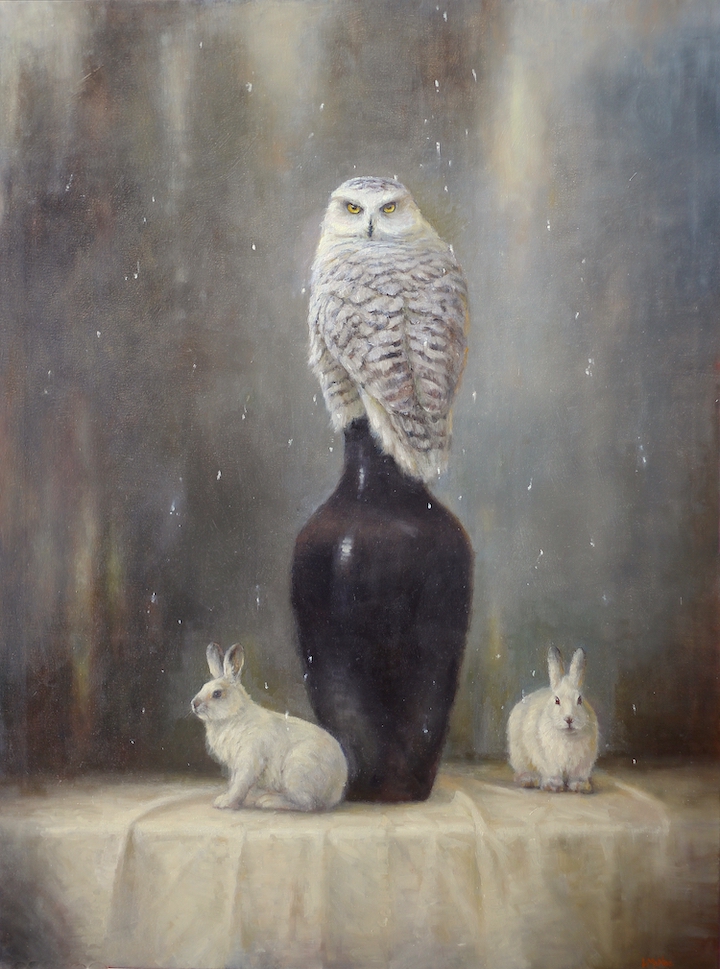
So, what is the secret to painting convincing whites? Read on to find out …
In the detail photo of my painting, “Still Life in Blue & White,” I put a white piece of paper next the the blue and white vase to illustrate how much color really goes into painting the illusion of white.
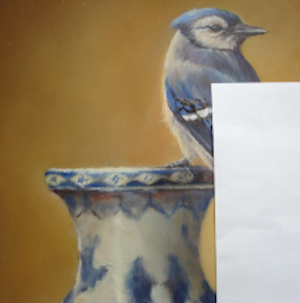
(You can watch a video of me painting the blue jay in this speed video demo).
First, it is good to understand the basics of ‘white’. Yes it is true that titanium, zinc and lead white are the main pigments for painting white and the effects of light in acrylic and oil. But there is more to painting ‘white’ than slopping a blob of white paint from a tube onto a canvas.
The challenge is this: Although white makes a color lighter, it also removes its vibrancy and brightness.
The two different categories of white
Light-Generated WHITE:
- White = the sum of all the colors of light.
- Yes, white is a color.
- White reflects all the colors of the visible light spectrum to the eyes.
- But, light appears colorless or white.
- Sunlight is white light that is composed of all the colors of the spectrum.
- A rainbow is proof.
- But, you can’t see the colors of sunlight except when atmospheric conditions bend the light rays and create a rainbow.
- A prism can also demonstrate this.
Pigment WHITE:(obviously, this is the ‘white’ we artists need to understand)
- Technically, pure white pigment is the absence of color.
- You cannot mix colors to create white.
- White is the absence of color.
- Conversely, when you examine the pigment chemistry of white, you will find ground-up chalk and bone or chemicals as titanium and zinc.
- These substances are used to create the many nuances of white in paint, chalk, crayons – and even beauty products.
- It can be said that white is a ‘color’ in the context of pigment chemistry.
So now we know that ‘white’ reflects all the colors of the visible light spectrum! That means in order to paint convincing whites we must be able to paint the subtle color shifts and value changes. Your white subject matter will reflect the colors of the objects that surround it. Therefore, the truth is this – convincing whites are actually quite colorful.
(The charming ‘white tea-cup’ demonstration above is by Karen O’Neil – look at all that color!!!)
*Remember, WHITE reduces brightness so although it makes a color lighter, it removes its vibrancy.

This are the reasons why:
- When white pigment is added to any color it produces a ‘tint’ of that color.
- This addition of white makes a transparent color opaque, and cools the original color.
- We have all seen this phenomenon with red.
- A warm, vibrant red will quickly change into a cool pink with the addition of titanium white.
- White can be used to lighten a color, but too much white causes dull, bleached out paintings.
- Learn to develop your own color sense and mixing skills to produce beautiful hues of varying intensity.
- Use white sparingly.
- To learn more about color, you might like to read The Hidden Meaning of Color
There are Three White Pigments:
- Titanium white paint is my choice and the most commonly used by fine artists. Titanium white is the most opaque white pigment. It very easily covers paint layers underneath it. Titanium is the most neutral in color but is slightly cool.
- Zinc white is made from pure zinc oxide and was originally developed in the 1700’s. It is somewhat translucent and produces brilliant color mixtures. Zinc white is known for its ease and workable quality in oils. But, this pigment tends to be very brittle and produces cold mixtures.
- Lead White or basic lead carbonate is one of the oldest known pigments which was first developed during the time of Christ. It produces very warm and intense color mixtures. It is considered to be the most enduring pigment. Many of the most revered qualities of the ‘old masters’ paintings can be attributed from the use of lead white. That said, it is of utmost importance to note that LEAD WHITE IS EXTREMELY TOXIC!
I hope you learned a thing or two about painting white! Thank you. ~Lori


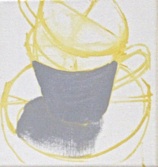
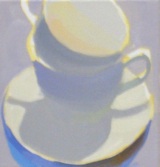
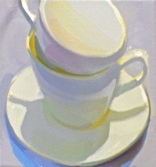







Lori! You are amazing….How do you find time to paint and write all these amazing blogs? I admire you and your work so much!
Creatively yours,
Wendy
Thanks for the complimentary comment, Wendy! I replied to your comment, but it got lost somehow…so please forgive me if I repeat myself. Anyway, painting, blogging and family is a lot to juggle, but I really enjoy helping others through my own experiences.
I looked at you website and really liked you old Montana style. Would you like to share a tip or helpful story with us? Please consider.
Thanks again and I hope you come back again soon.
Best
~Lori 🙂
This is hot! I like your attention to detail Lori, and I love the tremendous, stylistic confidence you have about your work!
Hi Sean! Thanks for checking out my blog. Glad you like it. Funny, I just was on your site and posted a comment. But, you will have to wait and see what I had to say – I don’t want to repeat myself here. I will say that I enjoyed my visit on your site!
Come back again when you need a little shot-in-the-arm of “art culture”! ~Lori 🙂
Lori
Thanks so much for the tips on painting white. I am attempting to do just that.
Barbara, I hope these tips on painting white help you with your project. Let me know how it works for you. Thanks for the visit and come back again soon. Also, let me know if you have any topic suggestions!
Lori 🙂
Hi Lori, its wonderful to have found your web-site and all of the information that you are sharing..It has made the difficulties I have been
struggling with for so long more able to understand..I am finding values hard to get a grasp on , but I am determined to learn with perserverance, and never say die attitude..Thank you so much…Annette
Hi Annette and thank you! Comments like yours are the reasons why I am taking time away from my own painting in order to blog & share what I know with others.
I hope you come back and visit. Values…hmmm…that will be an upcoming post!
Best- Lori 🙂
Nice! I’m new to your terrific site, but if you haven’t covered the subject in the past, here’s an idea: how *dark* and colorful reflections and highlights on dark hair and dark shiny subjects can be. Despite looking kinda white! Best, Karla Mulry
Hi Karla…nice to meet you! Are you offering to write a tip on *dark* & colorful reflections??? Would love to see what you have to say – please share. Or, are you asking for help on that subject?
Thanks for the comment – Lori 🙂
I really enjoyed thispost and seeing the steps of the “white” tea cup painting, love those vibrant blues! I have fun attempting to paint white objects, like lilies sometimes, I find it to be a good brain and mixing exercise like practicing the scales. Thank you for this and all of your posts, they’re always useful, fun and imformative!
I’ve always only used lead white and I love it (it much more toxic as powder or pigment which you cannot buy anymore) because it has an almost translucent quality that the other whites don’t have. Just my personal preference.
Thanks again Lori.
Hello Kelly and you are very welcome! I am so glad you enjoyed this article. It was a fun one to write. I have never used white lead because of its toxicity, but I know it creates beautiful effects.
I am grateful for your visit and comment!
Lori 🙂
Lori – I’m a fine-art photographer who has just taken his first, extremely faltering steps with brush and acrylic. Whenever I visit your site I am just in awe of the mastery your work displays. I’m just enjoying the process and getting a grip on the zen-like patience it demands of me.
I discovered the paradoxical colorfulness of white as a beginning photographer, and your comments about how quality of light affects white are spot on. Pure white in a photograph is actually – nothing! so one learns that lesson pretty quickly.
Best regards
David Roddis
Toronto
Hello David, thank you for your thoughtful comment. I appreciate your feedback. White is an interesting subject in art and photography!